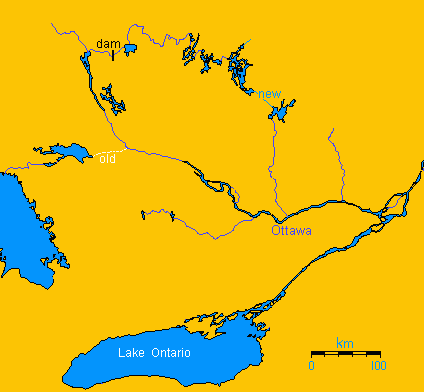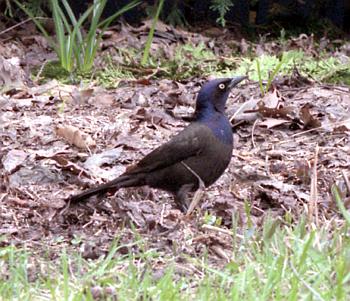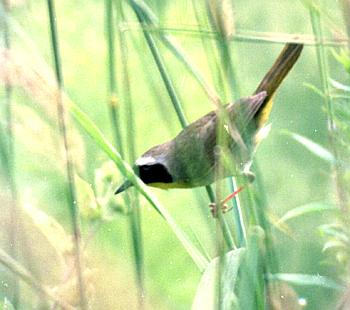Enjoying the Birds of the Ottawa Valley
The Ottawa! "The Great River" to Jacques Cartier and Champlain. The highway to the heart of
the Canada to come. And yet, to a naturalist, it is as recent as yesterday.
 Only 12,000 years ago, the Valley was imprisoned under the polar icecap, scraped clean of life
down to Ordovician limestone and Shield granite. Then came 2000 years at the bottom of the
Champlain Sea. A crucial time, when the clay and sand that are the foundation of both
agriculture and habitat diversity were laid down. Next, lasting until only 4000 years ago, came
the period when the Ottawa drained most of Canada, via Georgian Bay (the 'old' route shown
in white at right).
Only 12,000 years ago, the Valley was imprisoned under the polar icecap, scraped clean of life
down to Ordovician limestone and Shield granite. Then came 2000 years at the bottom of the
Champlain Sea. A crucial time, when the clay and sand that are the foundation of both
agriculture and habitat diversity were laid down. Next, lasting until only 4000 years ago, came
the period when the Ottawa drained most of Canada, via Georgian Bay (the 'old' route shown
in white at right).
Four hundred years ago, Europeans found it, a shadow of its former self, but still one of the
wildest rivers on the continent. "The Long Portage"! The name of the voyageurs for the 20
kilometers of rapids below Hawkesbury. Asticou! It translates into French as La Chaudière - the
Cauldron - at Ottawa. Petawawa! Algonquian for "a noise heard far away". And, surrounding it
all was a land in the perpetual gloom of a canopy of immense pines.
The earth's axis has tilted two degrees across the heavens since then. The birds, and we, have
seen many changes. The first shipment of wood grown on the fertile Valley clay was taken out
by Champlain in 1611. Before the big pines ran out, half a cubic kilometer of prime square
timber was exported, and an equivalent amount was exported as potash. Logging denuded the
land, but made space for agriculture, and created myriad places for previously barred birds to
live. Broken woods and pesticide-free suburbs often support twenty birds per hectare. The same
area of pure coniferous forest often houses only two.
During the last fifty years, we have submerged the rapids with hydro dams. The steady water
level has eliminated most mud flats, but the shorebirds use our new sewage lagoons instead. Our
burgeoning population has created a suburban environment inviting to many opportunistic
species.
But, 200 years ago, the pines, swamps and rapids were barriers to transport that divided the
Valley into three parts. The part up to Carillon was effectively an extension of the St. Lawrence.
The lower Valley, from Grenville to Ottawa, was settled from Montreal. The Upper Valley,
above the Chaudière, was settled by the land route through Prescott and Perth. As a result, the
extent of "The Valley" depends very much on whom you talk to. However, if you live within
sight of the Champlain sediments that extend from Deep River to Grenville, you probably
consider your town, and those upstream, to be the real Valley. Obviously, it has good vibes!
Some specific details in this book refer to the District of the Ottawa Field Naturalists, the area
within 50 km of Parliament Hill. It is the portion of the valley that has been studied the most.
Most of this book, though, is applicable to your Valley even if it extends from Montreal to
Capimichigama. (Lake Capimichigama is no longer the true source of the Ottawa River - since early
this century a dam at Lac des Quinze has diverted the water of the northern Ottawa down the 'new'
route on the map.)
Regardless of the defined boundaries, the Ottawa Valley is rich in bird life. Of the 581 species of
birds that have been recorded in all of Canada, more than half, 329, have occurred within the
OFNC circle. In any one year, 270 species normally make an appearance, although some
appearances are brief. More satisfying to many, 163 species breed here.
By the calendar, 50 species typically remain here all year, 112 visit for the summer, 19 for the
winter, while 61 normally appear only as they migrate along the Ottawa River each year to and
from arctic breeding grounds. (The remaining 87 species records were of avian accidents, such as
young birds who had faulty migration instincts, or birds that were blown here by storms.)
Barely 200,000 birds can survive the depths of winter here. But, some 5 million arrive to breed in
the spring. That results in 10 million birds, Valley born all, by the end of summer. And, about
100 million birds migrate south over our heads each fall. Truly, we are blessed!
An Introduction to Birds
If you appreciate birds, you are not alone. At least 25,000 Valley households regularly feed birds.
Close to 100,000 of us actively watch them. The Ottawa Christmas bird count has been at times
the second most popular of 1400 held world-wide.
It was not always so. A few decades ago, duck hunters were "he-men". Bird watchers were the
butt of media jokes. A few generations ago, our markets featured piles of bobolinks and snow
buntings. Hawks were slaughtered all over the continent just for the fun of it. A century ago, we
shot sandpipers and plovers by the millions for their pitiful few ounces each as food.
In most countries, people still do not appreciate birds the way we do now. In Italy, half a million
commercial bird shooters kill 150 million wild birds a year. But in Canada most birds are
protected by law, year round, from shooting and trapping of any kind. In the Valley, twice as
many of us feed finches as shoot waterfowl. The feeders are gaining day by day. (The Valley is
still gun country, however. Canada wide, the ratio is 5 feeders per hunter.)
Why are birds so fascinating to us? There are probably 100,000 answers.
Song is one. As Izaak Walton put it, "Lord, what music hast thou provided for the saints in
heaven, when thou affordest men such music on earth?" A century earlier, Shakespeare noted,
"the lark at break of day arising from sullen earth, sings hymns at heaven's gate."
Contact with nature is another. In contrast to modern man, nature reasserts the past. The more we
live in the natural world, the more attuned we are to cycle, rather than to change. Nature can
come to all of us, in the form of robins, swallows and other familiar birds. Their return each
spring means renewal, the continuity of life. After all, birds were in the treetops to warn of
tyrannosaurs, before primates like us were ever thought of.
Birds bring the world to us. The arctic reigns for part of the year, with cheery redpolls at our
feeders and solitary snowy owls scanning open fields. Then, it is the turn of the tropical rain
forest, to send us warblers who raise young in the security of our insect-laden woods. From tree
line to rain forest, from tundra to coral beach, from the steppes of Asia to the Atlantic ocean, they
come.
We envy the freedom that flight gives them. Along the hills of the Gatineau, golden eagles soar
majestically, a breath-catching sight for even the most seasoned watcher. Down the Ottawa,
dunlin flocks flash in uncanny unity, transforming from black to white and back again. The entire
continent is their home.
Birds are fascinating because they are so different from us, yet so alive, and so much a part of our
world. Here are some of the differences.
A Celebration of Feathers
 You probably have read that dinosaurs, the dominant land animals for 140 million years,
mysteriously vanished 63 million years ago. They didn't - only some of them did. Many survived,
as birds! Birds are the sons and daughters of dinosaurs, of small carnivorous coelurosaurs
of some 130 million years ago. The earliest known birds are almost indistinguishable from
small dinosaurs that probably ran after prey much as road runners do today.
(cf. National Geographic 196(5):98-107)
You probably have read that dinosaurs, the dominant land animals for 140 million years,
mysteriously vanished 63 million years ago. They didn't - only some of them did. Many survived,
as birds! Birds are the sons and daughters of dinosaurs, of small carnivorous coelurosaurs
of some 130 million years ago. The earliest known birds are almost indistinguishable from
small dinosaurs that probably ran after prey much as road runners do today.
(cf. National Geographic 196(5):98-107)
All birds have feathers. No creature other than birds does. Look at a feather! Supremely simple,
yet elegant. A central hollow shaft, incredibly light for its strength. Small tubular "hairs" grow on
each shaft. In turn, microscopic V-shaped vanes grow on each hair. Each vane is made of many
pancake-like cells. In some birds, such as blue jays, the cells scatter light as the sky does to
produce a blue colour. In others, such as grackles, they are so precisely aligned that they diffract
light, to produce every colour in the rainbow.
Feathers are actually modified reptilian scales, not hairs. Dinosaurs developed them both as
decorative structures and as down for warmth. And, warm they are. No furry animal can
withstand the antarctic winter as penguins do. Flight came later, it seems. Each slight increase in
lift of a feathered arm, waved like a tightrope walker for balance, let its owner jump higher, to
reach more flying insects with its long well-toothed snout.
Considering the beating they take, feathers are remarkably durable. Still, birds must spend
considerable time cleaning, combing, and spreading waterproofing oil on them. And, birds must
moult off all their flight feathers at least once a year and grow a new set. It's a perilous time,
when many species cannot fly. Despite these disadvantages, no creature, once with feathers,
appears to have ever given them up.
The Glory of Song
Song is the language of birds. They use it to announce territorial possession, to attract, woo, and
placate a mate, to warn of predators, to threaten rivals, to encourage young to feed, to keep flocks
together, to navigate in darkness. And, I am certain, simply to say "Oh, what a beautiful
morning".
Most songs are sufficiently different that they characterize their species. Some are as individually
distinctive as fingerprints. Listen carefully to a savannah sparrow's song. The first "zeep's" are
the same for all birds of the species. "I'm a Savannah." The second section is unique to the
individual bird. "I'm Joe." The trailing "buzz-chip" is specific to our local population. "I'm a
Valley boy." Once savannahs' territories are sorted out, the right call from the right place doesn't
interrupt normal activity. Energy is reserved for strangers, aliens to the web of boundary
agreements. They get the full territorial treatment.
The longest territorial bird song in the world can be heard here. Winter wrens, next-to-invisible
specks of bark-coloured energy, spout fountains of 110 notes covering 8 seconds from their
territories in moist tangled woods. The world record for the most loquacious bird was set just
west of the Valley, when Louise de Kiriline Lawrence counted 22,197 songs from a red-eyed
vireo in one day.
Bird song is difficult for us to understand. The smaller an animal is, the faster time passes for it.
A 7 gram warbler lives, and communicates, 10 times as fast as we do. Also, songbirds have two
sound-producing organs, and can use both at the same time. A bird literally talks out of both
sides of its mouth.
To us, a male cowbird song sounds like "glug-gleee". But, a prospective mate hears five distinct
syllables in the "glug" alone. The "gleee" starts with a short note so high I can barely hear it,
continues with two warbler-like notes, and ends with a four-octave glissando to a final note the
same pitch as the first. The whole song takes barely half a second, and if it isn't perfectly
done--no sex for you, buster!
Song is also produced by the wings. A ruffed grouse beats the air to produce a pure low sound
that owls can't locate. A snipe vibrates its tail feathers during flight to produce its "winnowing"
sound. Woodpeckers use their bills to produce distinctive sounds. Owls use their bills and
tongues to click during confrontations.
With such a variety of sounds from birds, it is small wonder that many of us consider ourselves
bird-listeners rather than bird-watchers.
The Miracle of Migration
 Migration is central to the lives of most birds, to an extent unique among all forms of life in this
region. Many of 'our' birds are actually tropical citizens (for 6 months of each year). They fly
here only to raise young (for 3 months).
Migration is central to the lives of most birds, to an extent unique among all forms of life in this
region. Many of 'our' birds are actually tropical citizens (for 6 months of each year). They fly
here only to raise young (for 3 months).
Bird migration is an annual movement. Our warblers alternate between two specific areas, a
nesting area here and a home area in South America. Waterfowl move only as far south as
needed to find open water and to get food. Some can remain at Manotick and the Ottawa rapids.
Others move only to the St. Lawrence River near Cornwall. Shorebirds spend more time
migrating than sitting in any one place. Some adults spend less than a month on their nesting
grounds. Their young can fend for themselves as soon as they hatch.
Why do birds migrate? Travel is risky. (We make it riskier with TV towers, like the one at Bath,
Ontario, that has killed 20,000 warblers in a single night.) Travel requires that you know where
you are going, and how to get back. It is so complicated that most people cannot do it without
special training, or maps. Food habits must be more adaptable for a travelling bird than for a bird
of fixed territory. But, birds make the answer clear simply by their existence. The risk that
inadequate food will be found to survive our winters is greater for most than the risks of
migration. Particularly if you specialize in eating insects.
Moving around denies year-round food to predators and parasites. A pure bird predator in the
Valley must be able to fly south with its prey to survive. (Or hibernate like raccoon dogs. That is
one reason why naturalists worked so hard to prevent their introduction a few years ago.)
Migration
forces our foxes and weasels to survive on rodents during the winter, so they take birds only
incidentally during the summer. Many bird parasites are unable to survive the cold of our
winters. Competition for nesting sites and food is lessened by migration to areas where few
resident birds can survive.
Still, how on earth did they ever learn to do it? Well, intelligence tests show that birds are
smarter than most mammals, smarter even than some primates. Despite this, half of young
warblers die their first autumn, solely due to their failure to migrate successfully. The route to
migration is through the amorality of natural selection, where success is self-defining.
main page
next page
 Only 12,000 years ago, the Valley was imprisoned under the polar icecap, scraped clean of life
down to Ordovician limestone and Shield granite. Then came 2000 years at the bottom of the
Champlain Sea. A crucial time, when the clay and sand that are the foundation of both
agriculture and habitat diversity were laid down. Next, lasting until only 4000 years ago, came
the period when the Ottawa drained most of Canada, via Georgian Bay (the 'old' route shown
in white at right).
Only 12,000 years ago, the Valley was imprisoned under the polar icecap, scraped clean of life
down to Ordovician limestone and Shield granite. Then came 2000 years at the bottom of the
Champlain Sea. A crucial time, when the clay and sand that are the foundation of both
agriculture and habitat diversity were laid down. Next, lasting until only 4000 years ago, came
the period when the Ottawa drained most of Canada, via Georgian Bay (the 'old' route shown
in white at right).
 You probably have read that dinosaurs, the dominant land animals for 140 million years,
mysteriously vanished 63 million years ago. They didn't - only some of them did. Many survived,
as birds! Birds are the sons and daughters of dinosaurs, of small carnivorous coelurosaurs
of some 130 million years ago. The earliest known birds are almost indistinguishable from
small dinosaurs that probably ran after prey much as road runners do today.
(cf. National Geographic 196(5):98-107)
You probably have read that dinosaurs, the dominant land animals for 140 million years,
mysteriously vanished 63 million years ago. They didn't - only some of them did. Many survived,
as birds! Birds are the sons and daughters of dinosaurs, of small carnivorous coelurosaurs
of some 130 million years ago. The earliest known birds are almost indistinguishable from
small dinosaurs that probably ran after prey much as road runners do today.
(cf. National Geographic 196(5):98-107)
 Migration is central to the lives of most birds, to an extent unique among all forms of life in this
region. Many of 'our' birds are actually tropical citizens (for 6 months of each year). They fly
here only to raise young (for 3 months).
Migration is central to the lives of most birds, to an extent unique among all forms of life in this
region. Many of 'our' birds are actually tropical citizens (for 6 months of each year). They fly
here only to raise young (for 3 months).